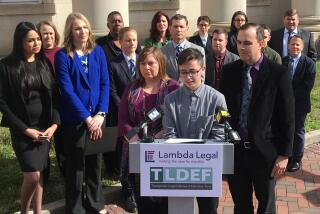U.S. Immigrants Facing Barriers to Homeownership, Study Finds
Immigrants will create a significant need for housing over the next two decades, but their ability to become homeowners could be undermined by high costs and other barriers in California, according to a new study.
Immigrants could create demand for 4 million or more new homes over the next two decades, according to a study released Thursday by the research arm of the Mortgage Bankers Assn. of America.
They could account for 200,000 non-rental units annually, or roughly the equivalent of 15% of the housing starts recorded in the U.S. last year if the home-building industry kept pace.
In Southern California, a chronic dearth of new construction has pushed home prices, always among the nation’s highest, to record levels while demand has increased.
High prices also have helped hold ownership rates in Los Angeles County to 50%, and the state ranks among the lowest in the nation in homeownership.
The gap between immigrant and native-born households is growing.
Many newcomers to the U.S. over the last decade had fewer skills, less income and education, compared with Americans, and no equity from a previously owned home, the study said.
And they are settling in gateway regions with high housing costs, such as Southern California.
“It’s a challenge for policymakers, for home builders and mortgage lenders in trying to bring immigrants into the mainstream,” said Jim Freund, one of the analysts who put the study together for the Washington-based research group.
Orange County had the widest gap of ownership between immigrant and non-immigrant households among 10 major metropolitan areas in the U.S., at 30%.
Los Angeles had the third-highest difference at 19%, the study found.
The report was based on current immigrants becoming homeowners over 20 years, a period used to analyze the progress of a previous generation.
From 1980 to 2000, for instance, the older group raised its ownership rate to 57% from 19.5%, the study said.
For newer immigrants, “there will be demand for housing, but the question is whether there will be a supply for that demand,” said Roberto Suro of the Pew Hispanic Center, a Washington research group.
Suro said he disagreed with the study’s conclusion that coming from a less-developed country is a key negative in homeownership.
Rather, he said, the overriding factors are housing costs and wages for low-skilled workers that include large numbers of immigrants.
Increasingly, he said, immigrants are moving from high-priced markets in California and elsewhere to smaller cities and suburbs with less expensive housing, Suro said.
“They’re acting like assimilated Americans,” he said, “and going where the housing is cheaper and jobs are better.”
Still, a recent study by Loyola Marymount University found that immigrants are optimistic about their children becoming homeowners someday.
In the survey of 1,200 people, 54% of Southern Californians overall said the next generation would be unable to purchase a home in the area when they become adults. But among residents born outside the U.S., only 43% said they believed today’s children will be unable to buy here.
John Karevoll, an analyst at DataQuick Information Systems Inc., said despite rising home prices, lenders are more willing to extend credit, including mortgages that require little or no down payments.
With historically low interest rates in the 7% range, the odds of immigrants becoming homeowners should improve.
“It’s a mixed picture for them,” Karevoll said, “but the prospects are brighter now for them than it has been in the past.”
More to Read
Start your day right
Sign up for Essential California for news, features and recommendations from the L.A. Times and beyond in your inbox six days a week.
You may occasionally receive promotional content from the Los Angeles Times.






